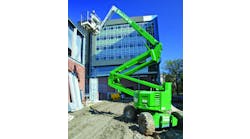While interviewing RER 100 executives for this issue, I noticed a recurring theme. It wasn't defined as such, but it was walking a kind of tightrope, on the razor's edge between cutting costs and the need to expand and grow in the middle of a downturn. Obviously nobody wants to spend a lot of money at a time they can ill afford to do so, yet at the same time, there's a strong drive everywhere to grow market share. It's a time of opportunity to possibly make a move while competitors may be retreating because of the same pressures. As Keith Olson, of Colorado Machinery (No. 79) said, “It is going to be a tougher year, so we have to be more aggressive than ever.”
The old business adage that says if your business isn't growing and going forward, it's going backwards, is on the minds of many RER 100 executives. Yet, at the same time, self-preservation is a primal instinct. Recognizing what you have to cut and doing so before it's too late is not always easy or apparent. It's a lesson many learned during the tough years early in this decade. Some who waited too long and didn't cut enough were slower to recover. The same can be said for those that cut too much and lost their aggressive edge.
Aggressive moves, while risky, can lead to greater success when business heats up again. Wrong decisions can of course hurt a business' chances of recovery.
A couple of years ago, most RER 100 executives said they expected double-digit growth. Last year, more often I heard expectations and hopes for single-digit growth. This year the prevailing theme was hoping for a flat year. Those who expressed that are not perpetual pessimists at all; they are simply being realistic. Yet many of those still mentioned expansion plans. At least four of the 100 are opening new branches this very month, and dozens mentioned plans to open at least a couple of new stores this year.
For smaller companies, opening a branch or two is a serious commitment and risk. Also some of the national players are planning on going forward with a degree of growth and expansion. There's a widespread sense that opportunities are out there and if you don't grab them, somebody else will.
In the early 2000s, there was too much inventory left over from the rapid over-fleeting of the late 1990s. With too much fleet sitting, the pressure becomes huge to get that equipment rented no matter what, causing heavy downward pressures on rates. The consensus from most of the RER 100 executives is that will not be as big a problem in the current downturn, although many, mostly earthmoving specialists (although all segments share concerns) are already strongly concerned about those pressures and what is already a more competitive rate environment. In the past few years more companies diversified their inventory and their targeted customer base, enabling them to shift emphasis more easily in a downturn.
How a company fares in a downturn is, to a great degree, determined by quality of management. At no time in the history of the rental industry have there been as many intelligent and well-prepared leaders in the rental business. However, the tendency to keep market share by slashing rates remains.
“Many Johnny-come-lately [owners] think equipment rental is a get-rich-quick business,” says Steve Stodghill of Sims Crane & Equipment (No. 35). “They have multiplied the economic problems in certain regions tenfold by renting, leasing, or offering for sale products at or below their actual payments just to stay afloat and make payments.”
As most know, this is not a get-rich-quick business. Careful planning is necessary and taking a long-term view is an absolute necessity. This year will bring trial by fire to many. Here's hoping, a year from now, that all of this year's RER 100 will still be around to tell about it.
You'll notice as you read through the RER 100 that there are, in fact, 110 companies listed. As we added new companies some of the companies bringing in $10 million or even $11 million in rental volume got pushed off the list. Since so many of those were past listees, we decided to expand the size of the list, although statistical comparisons noted in the issue include only the top 100 companies with the top 100 companies of previous years.





